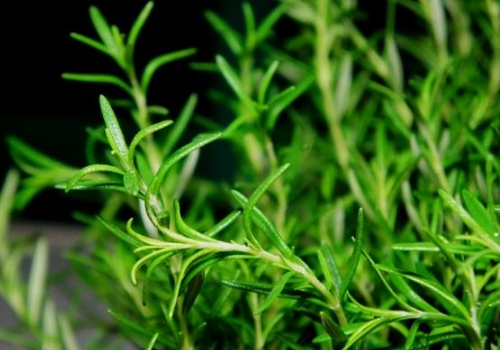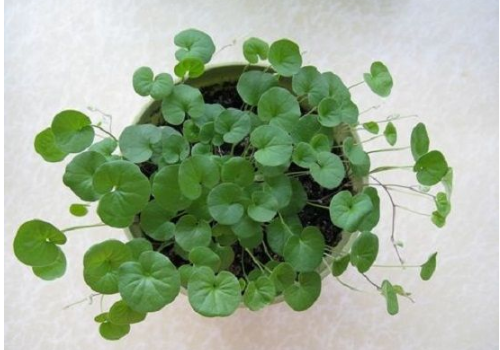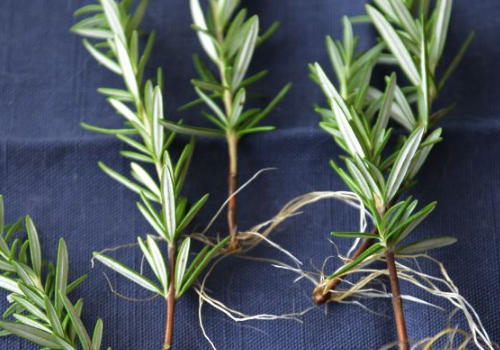The difference between the planting method of Rosemary seed and Salvia
Rosemary is a Labiatae shrub that usually grows in warm places, so how to grow rosemary seeds? The difference between sage and sage?
Planting methods of Rosemary seeds:
There are three main propagation methods of rosemary: sowing, cutting and striping, among which sowing and propagation is a more common one. However, because the germination rate of rosemary seed is not high, it is very important to master the correct seed planting method in order to ensure the germination rate.
Rosemary seeds are generally raised in the greenhouse in early spring, either by soil method or by burrow tray, but the germination rate is very low, generally only 10-20%, and the growth of rosemary is very slow in the first year, even if the plant size in autumn is not much larger than that when it was first planted, the formation of a large yield is very slow after 2-3 years. Therefore, asexual reproduction is generally used in production. But from the seed cultivation, the smell is more fragrant, so the use of breeding methods, depending on the needs.

The difference between rosemary and sage:
1. Differences between families and genera: although sage and rosemary both belong to angiosperm phylum and dicotyledonous class, they are very different after subdivision. Sage belongs to the aromatic plant of sage with petal subclass, while rosemary belongs to rosemary shrub of chrysanthemum subclass.
two。 Morphological differences: sage is shrubby, relatively short, leaves oval, hairy, gray-green or white-green, verticillium purple, pink or white, flowers with irritating aroma, early flowering. Rosemary has higher plant type, dark gray stem, hairy young branches, from four-prism to cylindrical in the process of growing into old branches, leaves clustered, short stalked or sessile, flowers opposite, flowering later.
3. Difference of origin: according to the different growth habits of sage and rosemary, their growth areas are also very different. In China, sage is generally distributed along and south of the Yangtze River, except for plateaus and basins, while rosemary can also be planted in Shandong as an cash crop.
4. Difference of medicinal value: sage as a herb, its main effects include clearing heat and detoxification, promoting blood circulation and removing blood stasis, reducing swelling and regulating menstruation, etc., mainly for jaundice, dysentery, sore dampness-heat, falling injury and so on. It is also traditionally used for hospital disinfection. The main medicinal function of rosemary is to calm the mind and awaken the brain, mainly for insomnia, headache, palpitation and so on.
All right, buddy, you know the difference between rosemary and sage.
When does rosemary bloom (months) the difference between sage and rosemary
The main function of rosemary is not to watch flowers, so people do not expect the florescence of rosemary so much that most people ignore the existence of rosemary flowers, but rosemary is indeed a plant that can bloom. As for when it will bloom, let's find out with the editor.
When does rosemary blossom
Rosemary is a perennial herbaceous plant. The natural flowering period is from November to April. The top and top of the branch are covered with light blue and white flowers. However, in a relatively cool environment, rosemary may also blossom from June to July.
The difference between sage and rosemary
1. The difference between families and genera.
Although sage and rosemary both belong to angiosperm phylum and dicotyledonous class, they are very different after subdivision. Sage belongs to the aromatic plant of sage with petal subclass, while rosemary belongs to rosemary shrub of Compositae.
2. Morphological difference.
Sage is shrubby, relatively short, leaves oval, hairy, gray-green or white-green, verticillum purple, pink or white, flowers with irritating aroma, early flowering. Rosemary has higher plant type, dark gray stem, hairy young branches, from four-prism to cylindrical in the process of growing into old branches, leaves clustered, short stalked or sessile, flowers opposite, flowering later.
3. Difference of origin
According to the different growth habits of sage and rosemary, their growth areas are also very different. In China, sage is generally distributed along and south of the Yangtze River, except in plateaus and basins, while rosemary can also be planted in Shandong and cultivated as an cash crop.
4. the difference of medicinal value.
Sage as a herb, its main effects include clearing heat and detoxification, promoting blood circulation and removing blood stasis, reducing swelling and regulating menstruation, etc., mainly for jaundice dysentery, sore dampness-heat, falling injury and so on. It is also traditionally used for hospital disinfection. The main medicinal function of rosemary is to calm the mind and awaken the brain, mainly for insomnia, headache, palpitation and so on.
Pruning method of Rosemary
When pruning rosemary, it is mainly divided into plastic pruning and harvest pruning.
Shaping and pruning is mainly in the growth process of rosemary, the branches will continue to grow, basically every leaf axilla will grow small buds, with the growth of branches, these buds will gradually develop into new branches, so after a long period of growth, the whole rosemary plant is called showing a messy state, branches are horizontal, and will affect ventilation and light transmission. Rosemary is prone to some diseases and insect pests. Therefore, in order to make rosemary grow better and have a beautiful plant shape, it can be pruned regularly and its shape can be arranged.
Harvesting and pruning is also a common way. In the process of the growth of rosemary, it can be harvested many times, and the branches and leaves of rosemary are mainly harvested. The method of harvesting and pruning is relatively simple, which can be trimmed with scissors or picked directly by hand. When harvesting, it should be noted that the juice in the wound of rosemary will become dry and difficult to remove, so it is necessary to do a good job of protective harvest when harvesting and pruning. At the time of harvest, it can be harvested 4 times a year according to the growth of rosemary.
The role of Rosemary
1. Help sleep
Rosemary flowers and seeds can relieve headaches, help sleep and prevent hair loss. Many families like to use incense to enter the water, and what they buy from the market are some chemical agents. Where can they compare with the natural plant aroma? At the same time, rosemary also has the effect of sterilization and anti-pain.
2. Improve your memory
Rosemary can eliminate flatulence, enhance memory, wake up and worry, relieve headaches and hair loss. Make tea with rosemary, smell the fragrance can refresh the brain, enhance brain function, Zeng Qing memory, put a small basin in the study, both fragrant and awakening! Students who need a lot of memory can drink rosemary tea.
3. Increase your attention
Rosemary can improve language, vision and hearing disorders, enhance attention, treat rheumatism, strengthen liver function, reduce blood sugar, help to treat arteriosclerosis and restore vitality to paralyzed limbs.
4. Beauty and skin care
Rosemary has a strong astringent effect, can help us clean hair follicles and skin deep, and can make pores smaller, thus making the skin look finer and smoother.
5. Lose weight
Rosemary scented tea can promote blood circulation, lower cholesterol, inhibit obesity, and has the effect of losing weight.
Rosemary flowers are very small and sporadic, so meeting a flower and enjoying it is also a kind of respect for the plant itself, but a more advanced form of respect is not to waste, try to make the best use of things, give full play to the value of rosemary.
How to sow lavender seeds? Planting method of lavender seed
Picture: lavender
[FAQ] how to sow lavender seeds? Planting method of lavender seed
[expert answers]
Tools / materials: flowerpots, seeds, garden soil, gardening tools, etc.
Methods / steps:
1. Container
Lavender is a perennial shrub, which can be used for about 10 years. The variety is extensive, easy to cultivate, sunny, heat-resistant, drought-resistant, extremely cold-resistant, barren-resistant, saline-alkali resistant, and the cultivation site needs sufficient sunshine and good ventilation. The time from sowing to flowering (or harvest): 18-20 weeks. Lavender should be cultivated in containers above medium size.
2. Plant materials
Lavender seeds are relatively small, and the budding rate is low, so the general sowing soil needs to be loose, breathable, high water holding capacity and sufficient disinfection in order to fluffy soil. If possible, you can use mixed soil such as plant lime soil, vermiculite, peat, water moss, perlite, serpent sawdust, or buy special soil for growing flowers in the flower and plant market.
3. Soak in warm water
Lavender seeds should be soaked in warm water below 40 degrees Celsius. It is easier to germinate after soaking for 12 hours after cooling.
4. Sowing method
Generally larger seeds (such as lavender, sage, rosemary) can be used every 3-5 cm according to the area of each container. After germination, the stronger seedlings were retained depending on the growth status of the seedlings. Small seeds (such as Mayoram) can be sown over a large area. Touch some seeds with your hands and sprinkle them gently on the soil. The seedlings sprouted after germination. Leave 1-3 seedlings as appropriate.
5. Cover the soil
The thickness of seed cover depends on the size of the seed. It is generally 2-3 times the diameter of the seed. The small seed soil should be covered thinner, and the soil covered by lavender seeds is less than 1 cm. Some seeds have strong phototaxis and can not be covered with soil (such as vanilla, rosemary).
6. Moisturizing
Water thoroughly at one time after sowing. A fine spray can is used for watering. Don't push hard so as not to wash the seeds away. It is best to use the sitting basin method, that is, use a large basin to hold 3 basins of water, and sit the container in the basin. Let the water seep in through the bottom hole of the container (the water level in the large basin should not exceed the height of the soil in the container). After sowing, you can also cover the container with plastic film and pierce a few small holes to breathe. Put the container in the sun and keep it at a temperature of about 20 degrees. Most seeds can germinate after a week.
7. Post-germination management
After the lavender seeds germinate, you can take off the cling film. If the seed is small, you can take it off until the seedling is a little stronger.
8. Upper basin transplantation
After the lavender seeds planted in a large area germinate, the seedlings can be put on the flowerpot after growing 4-6 true leaves. Note that the distance between the seedlings is generally 3-5 cm. You need to use a small basin at the beginning. Wait for the seedling to grow up, and then replace the big basin as appropriate. When changing the basin, wait until the soil is dry (because it should be watered after changing the basin, if the soil is wet, the wet time is too long, and the seedlings are easy to grow poorly). First, add more than half of the fertile soil to the small basin. In order not to destroy the root system, there is no need to shake off the soil near the root when transplanting. Move it directly into a small basin and fill the soil with the roots. Be sure to water thoroughly and shade for a few days after transplantation. And then you can put it in the sun for maintenance.
[editor's comments] after the introduction and cultivation of lavender in China, lavender has always been favored by the public, so how to sow lavender seeds? You know, the germination rate of lavender seeds is not high, many flower friends reported that sowing failed, here the first agricultural editor summarized some good methods and suggestions, the above introduced the tools and steps needed for lavender seed sowing, and so on. I hope everyone can plant lavender with seeds.
- Prev

Is Dichondra poisonous? how to plant hanging seeds?
Dichondra has a very good essence, and it can also be put into the bedroom. Is it poisonous? How to plant hanging seeds? Is Dichondra poisonous: Dichondra is not poisonous. Dichondra repens is a common herbal medicine, which has the functions of protecting liver and lowering enzymes, analgesia, anti-inflammation, antibacterial, antipyretic and cholagogic.
- Next

The method of hydroponic culture of rosemary when it blossoms
Rosemary is generally eaten as a spice and can also be used as an essential oil to protect the skin, so when will rosemary bloom? The method of hydroponics? When does Rosemary blossom: Rosemary is a perennial herb. It naturally blossoms from November to April, and the upper and top of the branch when it blossoms.
Related
- Fuxing push coffee new agricultural production and marketing class: lack of small-scale processing plants
- Jujube rice field leisure farm deep ploughing Yilan for five years to create a space for organic food and play
- Nongyu Farm-A trial of organic papaya for brave women with advanced technology
- Four points for attention in the prevention and control of diseases and insect pests of edible fungi
- How to add nutrient solution to Edible Fungi
- Is there any good way to control edible fungus mites?
- Open Inoculation Technology of Edible Fungi
- Is there any clever way to use fertilizer for edible fungus in winter?
- What agents are used to kill the pathogens of edible fungi in the mushroom shed?
- Rapid drying of Edible Fungi

